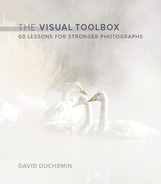Lesson 14. Isolation: Use a Wider Aperture
We’ve already touched on the ability of a longer lens to isolate subjects and give them greater visual mass, or pull on the eye, than they might have otherwise. A shallow depth of field can strengthen that, but it doesn’t have to be used in conjunction with a long lens. In fact, photographs made with a wider lens can often benefit because the wide lens makes background control difficult, simply by virtue of there being so much more background to wrestle into place. A softer focus on the background can diminish the pull on the eye, which in turn strengthens the impact of the elements in focus. Here’s what you need to know about depth of field.
Nikon D800, 300mm, 1/1250 @ f/7.1, ISO 400
The f/7.1 setting at the 300mm focal length, along with the extreme proximity of my subject, is a relatively wide aperture and blurs the background beautifully.
“A softer focus on the background can diminish the pull on the eye, which in turn strengthens the impact of the elements in focus.”
• Depth of field at any given aperture is narrower if your subject is closer than if your subject is further away. Camera-to-subject distance matters, so if you want way less depth of field, and you’ve opened your aperture as wide as you can, get closer. Vice versa—if you want more depth of field at a given aperture, step back a little.
• Depth of field can be seen through the lens, but only if you tell the camera to stop the lens down for you. Remember when you read the manual? That was the button called the Depth of Field Preview button. Using it will cause the viewfinder to get dark, which makes things harder to see, but I find the DOF Preview to be very helpful.
• It’s helpful to know that the in-focus zone in front of, and behind, the subject are not the same. The in-focus subject does not evenly split the in-focus zone, but cuts it in thirds: one-third in focus in front of the subject, two-thirds behind the subject. Knowing this allows you to pull the focus back toward you if you’re finding the background too sharp and you’ve already opened the aperture as far as you can. Or you can get closer.
Nikon D3s, 600mm, 1/1250 @ f/8.0, ISO 400
With a 600mm lens focused this close, f/8.0 provides very shallow depth of field, allowing me to keep most of this Stellar Sea Eagle in focus while keeping the background, cluttered with sea ice to form soft bands of blue instead of a sharply detailed background that would compete for my attention.


